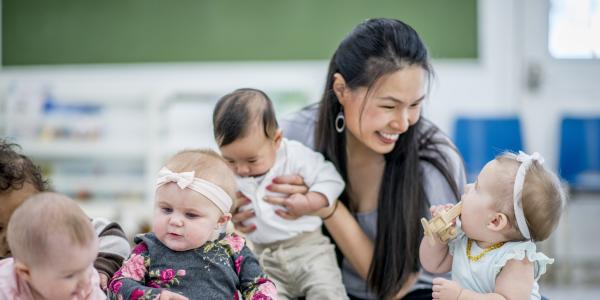Principles of Child Development and Learning

You are here
Home / Resources / Position Statements / Advancing Equity in Early Childhood Education Position Statement / Evidence for the Advancing Equity Position Statement / Principles of Child Development and Learning
- Early childhood (birth through age 8) is a uniquely valuable and vulnerable time in the human life cycle. The early childhood years lay the foundation and create trajectories for all later learning and development.10, 11, 12
- Each individual—child, family member, and early educator—is unique. Each has dignity and value and is equally worthy of respect. Embracing and including multiple perspectives as a result of diverse lived experiences is valuable and enriching for all.
- Each individual belongs to multiple social and cultural groups.13 This creates richly varied and complex social identities (related to race, gender, culture, language, ability and disability, and indigenous heritage identities, among others). Children learn the socially constructed meanings of these identities early in life, in part by recognizing how they and others who share or do not share them are treated.14, 15, 16, 17, 18, 19 Early childhood educators and early childhood programs in centers, homes, and schools play a critical role in fostering children’s development of positive social identities.20, 21, 22
- Learning is a social process profoundly shaped by culture, social interactions, and language.23, 24 From early infancy, children are hardwired to seek human interaction.25 They construct knowledge through their interactions with people and their environment, and they make meaning of their experiences through a cultural lens.26, 27
- Language and communication are essential to the learning process. Young children who are exposed to multiple linguistic contexts can learn multiple languages, which carries many cognitive, cultural, economic, and social advantages.28 This process is facilitated when children’s first language is recognized as an asset and supported by competent speakers through rich, frequent, child-directed language as the second language is introduced.29, 30, 31
- Families are the primary context for children’s development and learning.32 Family relationships precede and endure long after children’s relationships with early childhood educators have ended. Early childhood educators are responsible for partnering with families to ensure consistent relationships between school and home. This includes recognizing families as experts about their children and respecting their languages.33 It means learning as much as possible about families’ cultures in order to incorporate their funds of knowledge into the curriculum, teaching practices, and learning environment.34 It also means actively working to support and sustain family languages and cultures.35 Finally, it means recognizing and addressing the ways in which early childhood educators’ own biases can affect their work with families, to ensure that all families receive the same acknowledgment, support, and respect.36
- Learning, emotions, and memory are inextricably interconnected in brain processing networks.37 Positive emotions and a sense of security promote memory and learning. Learning is also facilitated when the learner perceives the content and skills as useful because of their connection to personal motivations and interests. Connections to life experiences and sense of mastery and belonging are especially important for young children.
- Toxic stress and anxiety can undermine learning.38 They activate the “fight or flight” regions of the brain instead of the prefrontal cortex associated with higher order thinking. Poverty and other adverse childhood experiences are major sources of toxic stress and can have a negative impact on all aspects of learning and development.39, 40 Protective factors that promote resilience in the face of adversity include supportive adult–child relationships, a sense of self-efficacy and perceived control, opportunities to strengthen adaptive skills and self-regulatory capacity, cultural traditions, and sources of faith and hope.41
- Children’s learning is facilitated when teaching practices, curricula, and learning environments build on children’s strengths and are developmentally, culturally, and linguistically appropriate for each child.42, 43, 44, 45, 46, 47 That is, teaching practices, curricula, and learning environments are meaningful and engaging for every child and lead to challenging and achievable goals.
-
Reflective practice is required to achieve equitable learning opportunities. Self-awareness, humility, respect, and a willingness to learn are key to becoming a teacher who equitably and effectively supports all children and families.48